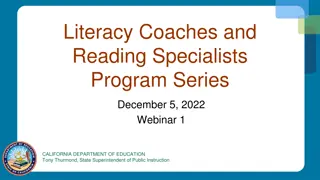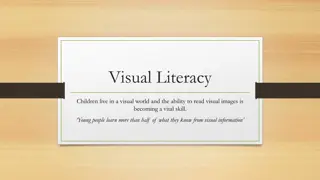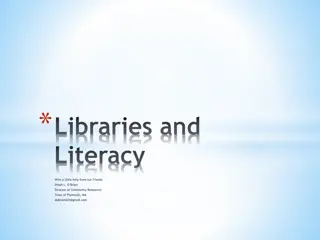Mobile Information Literacy Curriculum Overview
The Mobile Information Literacy Curriculum focuses on equipping individuals with essential skills to navigate the digital world effectively through mobile devices. It covers topics such as web searching, online work, information evaluation, and project presentations. The curriculum aims to bridge the gap in digital literacy education by addressing the unique challenges and opportunities presented by mobile internet usage. Learn more at http://tascha.uw.edu/mobile-information-literacy-curriculum.
Download Presentation

Please find below an Image/Link to download the presentation.
The content on the website is provided AS IS for your information and personal use only. It may not be sold, licensed, or shared on other websites without obtaining consent from the author.If you encounter any issues during the download, it is possible that the publisher has removed the file from their server.
You are allowed to download the files provided on this website for personal or commercial use, subject to the condition that they are used lawfully. All files are the property of their respective owners.
The content on the website is provided AS IS for your information and personal use only. It may not be sold, licensed, or shared on other websites without obtaining consent from the author.
E N D
Presentation Transcript
MOBILE INFORMATION LITERACY CURRICULUM Module 6 Slides: Module 5 Project Presentations
These slides accompany the Mobile Information LiteracyCurriculum: Module 6 Guide: Module 5 Project Presentations About the Curriculum As millions of people come online across the globe through mobile devices, mobile information literacy is vital for those who have leapfrogged from traditional media to digital devices that provide instant access to information. Mobile information literacy is necessary to help people learn how to find and evaluate the quality and credibility of information obtained online, understand how to create and share online information effectively, and participate safely and securely. Mobile information literacy is critical to help people better consume, generate, and disseminate trustworthy information through both digital and traditional media. The curriculum focuses on critical thinking in a digital environment of smart phones, mobile phones, and tablets, filling a critical gap in digital information literacy curricula. Existing curricular models assume people learn on a personal computer (PC). While this has been the case historically, the next billion people coming online will most likely learn on a mobile device. This has huge implications for how people get online, how they access and experience the internet, how much they produce in addition to consume information, and even how they conceptualize the internet itself. For instance, research shows that in Myanmar (and many other countries) more people use Facebook than the internet. Mobile-specific practices, such as zero-rating, mean people are coming online much more frequently through a handful of walled garden applications without an understanding of and similar access to the broader internet. Also, some mobile applications and websites don t offer the full functionality of their PC counterparts. The curriculum aims to address these differences and empower mobile internet users to be equal participants in the online world. Module 1: Introduction to Mobile Information and Communication Technologies (ICTs) Module 2: Introduction to the Mobile Internet Module 3: Basic Web Searching via Mobile Devices Module 4: Working Online and Using Information via Mobile Devices Module 5: Putting It All Together Module 6: Module 5 Project Presentations More information about this curriculum canbe found here: http://tascha.uw.edu/mobile-information-literacy-curriculum The curriculum materials are offered here with a Creative Commons Attribution-ShareAlike 3.0 license, so others are free to use, adapt, and share the materials with attribution. We are also available to help organizations create customized materials based on their particular country or regional contexts and literacy training needs. If you have questions on the curriculum or would like more information on how we can help, please email us at tascha@uw.edu. We also encourage individuals and organizations that use and adapt this curriculum and training to provide us with any feedback, ideas, and adapted materials. There are many ways you can do this: email tascha@uw.edu, leave a comment and upload materials on the main Mobile Information Literacy curriculum webpage http://tascha.uw.edu/mobile-information-literacy-curriculum, and/or participate on our Facebook page https://www.facebook.com/MobileInformationLiteracy. Recommended Citation Day, S. (2015). Mobile Information Literacy Curriculum Module 6 Guide: Module 5 Project Presentations. Seattle: Henry M. Jackson School of International Studies & the Technology & Social Change Group, University of Washington Information School.
Module 6 Description Module 5 Project Presentations In this module, groups will share their project results with an audience. Prerequisites: Module 1: Introduction to Mobile Information & Communication Technologies (ICTs) Module 2: A Mobile Lens on the Internet Module 3: Basic Web Searching via Mobile Devices Module 4: Working Online and Using Information via Mobile Devices Module 5: Putting It All Together
Outline Module overview Presentations (Groups 1, 2, & 3) Break Presentations (Groups 4 & 5) Discussion and Recap Post Survey
Module 6 Overview Topics covered: Presenting Mobile Information Literacy project-based learning Objectives covered through the end of this module: Present mobile information literacy project using your newly- acquired mobile and digital information literacy skills and knowledge Duration of module: 3 hours (180 minutes)
Project Presentations Things to Include: The name of your project What your projects is What you did Any issues you encountered, and how you resolved them Any aha moments you encountered What you learned from the experience What you might do differently in the future as a result
End of Module 6 Congratulations!!! You have completed Module 6: Module 5 Project Presentations
This is a product of the Information Strategies for Societies in Transition program. This program is supported by United States Agency for International Development (USAID), Microsoft, the Bill & Melinda Gates Foundation, and the Tableau Foundation. The program is housed in the University of Washington's Henry M. Jackson School of International Studies and is run in collaboration with the Technology & Social Change Group (TASCHA) in the University of Washington s Information School, and two partner organizations in Myanmar: the Myanmar Book Aid Preservation Foundation (MBAPF) and Enlightened Research Myanmar (EMR).























